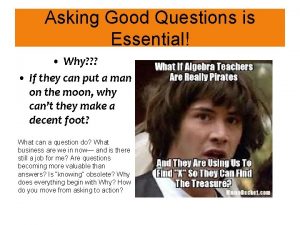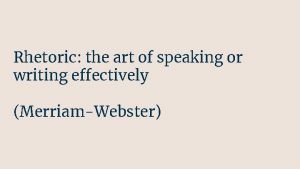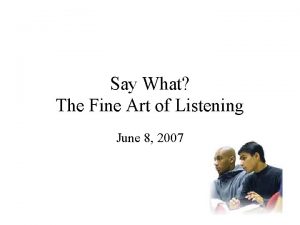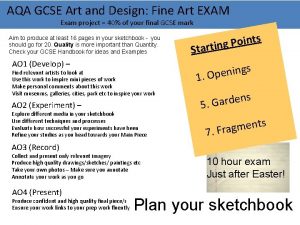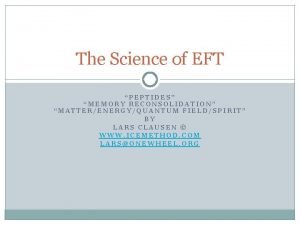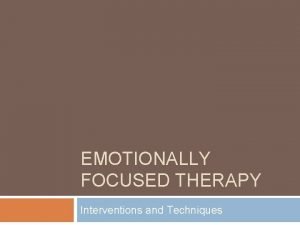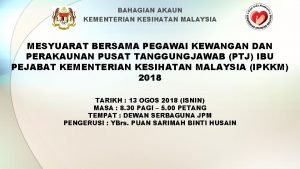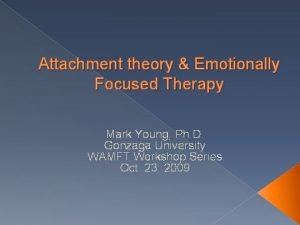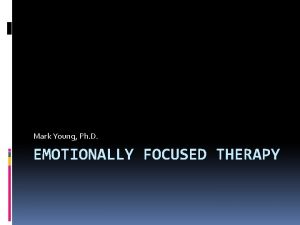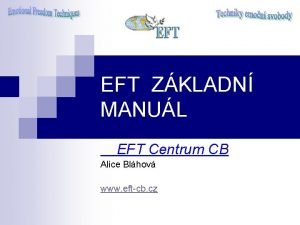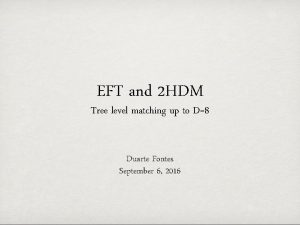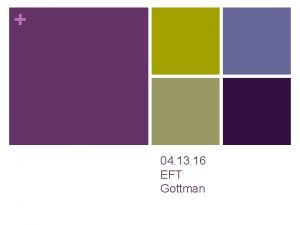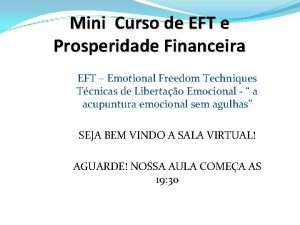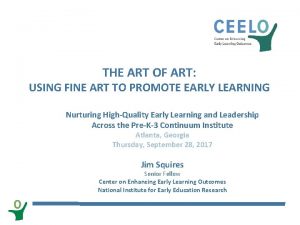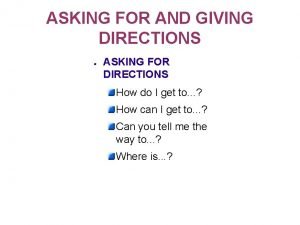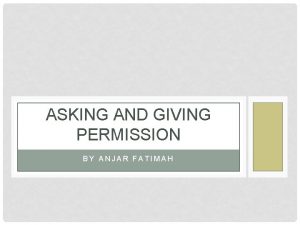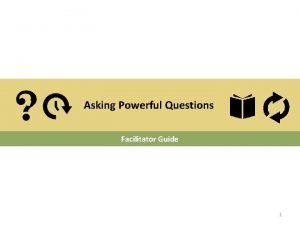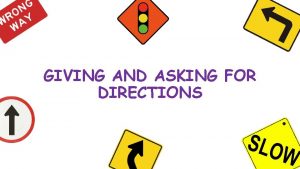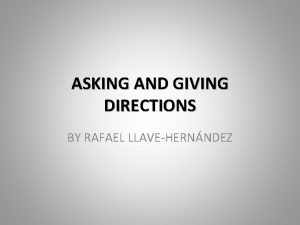Using EFT Effectively The Fine Art of Asking
































- Slides: 32

Using EFT Effectively The Fine Art of Asking, or Not Asking, Questions Copyright 2015 Ann. Adams. com Ann@Ann. Adams. com

Objectives Differentiation – EFT process is same but, because people can be very different, the approach, use and timing of that same process of EFT can vary. Engagement – It’s all about learning who you are dealing with. Problem Solving – Useful languaging variations. Copyright 2015 Ann. Adams 2

Three Bridge Phobias 3 Copyright 2015 Ann. Adams

Same problem different presentations: Louise: Excited about new job but has to cross bridge to save 1½ hour each way to work. Tired of and embarrassed about having the challenge of bridge. “I think EFT can help. ” Virginia: C/O problem with Boyfriend and not getting along with mother (who suggested she come) and btw boss unhappy because she’s late to work so much. “What’s the big deal, I work late a lot too. ” Sally: Hx of meds and therapists and says they are not helping. Spotty job history. Comes in looking very anxious. “I’m so jumpy about 4 everything. I can’t even cross the bridge. ”

Important to… O Develop *rapport, and safety O Understand how she sees the world. O Focus the session from responses - verbal and emotional. O Develop specifics and relevant Setup language, when EFT is appropriate. Know who you are dealing with. 5 *Comfortable Environment, calm, friendly, interested, listen, educate

Common Open Questions O What brings you to see me today? O How does this issue show up in your life? When did it start? O How do you usually deal with this problem? O What makes it better/worse? O What’s your experience with EFT? O What are your expectations for this session? 6 Copyright 2015 Ann. Adams

Where is she? You want to discover her road map of experiences Copyright 2015 Ann. Adams 7

Her stories O Help you both discover events behind O what drives her, O what injunctions she follow, O what decisions were made. O Help you develop Setup statements, reminder phrases and reframes. 8 Copyright 2015 Ann. Adams

Questions help her to O Increase her awareness, O Develop new ways of thinking about issue and self. O Expand the choices she sees, O Make better decisions, O Shift patterns of thinking and behavior. 9 Copyright 2015 Ann. Adams

Louise Ready, Willing, Able Stage of change 2 nd best predictor of client success. Copyright 2015 Ann. Adams 10

Categories of Questions O Common questions used by EFT Practitioners can be looked at in various categories. O Environmental O Physical O Behavioral O Identity Copyright 2015 Ann. Adams 11

PHYSICAL: Sight: What is it exactly about how it looks that affects you? What other characteristics do you see that impact your reaction: how big, how many, moving or still, colors, etc. Taste: Any tastes involved with your phobia? Smell: Any smells involved with your phobia? Sound: What sounds are involved? What is it about that sound that is upsetting? What does the sound remind you of? Feeling: What are the sensations in your body when confronted with your phobia? Where do you feel the fear when you think about the phobia? What textures could be involved? Emotion: What emotion is generated? What is the threat to your safety? Are you alone, isolated? Is it a person or people, crowds? How do you feel emotionally about having this problem? Can be repetitive: What the worst of… what’s worse of that? Fromthe. Deskof. Ann. Adams. com/Intro. EFT

ENVIRONMENTAL: History, Who, what, when, where, how When did this start? Is there another time you’ve felt like this? Are there any scenes or memories associated with the phobia? What events in your past could be associated with the phobia? What was happening when you developed this phobia? Currently, what life situations trigger the phobia? Can you recall what was happening in your life within a year or two of the onset? Are there particular places associated the phobia? Are certain people or places more likely to trigger the phobia? Who else could be involved in preventing a resolution of the phobia? What people in your past influenced this phobia? Who else in your family/friends shares this phobia? What would their reaction be if you resolved your phobia? Download: Guide to Effective Use of EFT Fromthe. Deskof. Ann. Adams. com/Intro. EFT

BEHAVIORAL – Thinking/Doing Are there things that you do or don’t do that affect this phobia? What have you done to attempt to resolve this? What thoughts most often go through your mind when confronted with the phobia? IDENTITY: Meaning, Gain/Loss, Fantasy Questions What does having this phobia mean to you? What does having this phobia mean about you? What could be a benefit about this phobia? What would you be doing if you didn’t have this? What would you be giving up if you didn’t have this? What losses does it cause? Self worth? Activities? Independence? And, if you don’t know the answers. GUESS. How do you know you do not know? What’s your theory about the cause of this problem? Fromthe. Deskof. Ann. Adams. com/Intro. EFT

What comes up for you now? Most non-leading generic question of all! 15

Questions are most successful when like Louise O Client is in some emotional pain. O Client is motivated to act. O Client has good “ego-strength” i. e. ability to self calm Expected in the Western Culture O Generally motivation is increased when paying for services. Questions expected and generally helpful. Copyright 2015 Ann. Adams 16

Goal of Questions – To Get Specific O The devil (and God) is in the details: When, where, what, how, with whom – O “We do not help any one until we get to a specific time, a specific place and a specific person. ” David Burns – CBT Expert Feeling Good Handbook 17 Copyright 2015 Ann. Adams

Virginia Reluctant, Protective, Denial Work to respect and understand their view of world. Copyright 2015 Ann. Adams 18

Process rarely a straight line 19 Copyright 2015 Ann. Adams

We are all Ambivalent! O If not resistant, change would have already happened. O It shows how we see/deal with change. O Our attempt to anxiety. O Desire to change can shift with issue. We can all join this group a some point! O See this as an opportunity to change YOUR approach Can go only as fast as the slowest part is willing. Copyright 2015 Ann. Adams 20

Emotionally compelling reason = Change Copyright 2015 Ann. Adams 21

Clarifying the choice O Push and pull O Win and lose O Up and down O Gain and Loss O Good and bad O Negative and positive O Status Quo and change Well something's lost, but something's gained. . . Copyright 2015 Ann. Adams Joni Mitchell 22

The No Questions particularly useful when client is ambivalent Share with me what it was like for you. Tell me a bit more about that. Describe the opposite of worrying Explain how this shows up in your life. Clarify what you mean by… Give me an example of… Help me understand the problem with… Summarize what you just said about. . . Curious Commands – It’s HOW you say it! Copyright 2015 Ann. Adams 23

Note the difference Question: When this problem is no longer a problem, how are things different? CC: If this problem were no longer a problem, share with me how things would be different for you. Emphasis: What did you do? Tell me what you did. 24 Copyright 2015 Ann. Adams

Lots of Empathic Statements O No more than 2 questions then empathic statement. I sense there is a part of you that is struggling to let go of… It seems really tough for you to talk about this. I’m puzzled as to your concerns about… Listening to you I am picking up fear that if you do [this] then [that]. 25 Copyright 2015 Ann. Adams

Sally Chronic, Complex, Traumatic Empathy, slow, teach self calm, trauma? , refer? Copyright 2015 Ann. Adams 26

Watch for O Highly anxious O Overly suspicious O Angry O Body posture O Dissociative O Eyes-staring/rigid O Emotionally fragile O Voice –high, loud O Low ego strength O Hyper vigilant O Self calm skills? O Easily triggered O Overly trusting Signals to slow down, reassess, calm, ground Copyright 2015 Ann. Adams 27

Go Slowly O Your calmness is O Not focus on body if contagious. O Watch closely for signs of upset. O Assure able to feel grounded? O Stop at any peak of intensity O Start small highly aroused or dissociated. O Educate O Less is more. Need time for integration. O Referral? 28 Copyright 2015 Ann. Adams

Best Use of Questions O To Clarify: Is that right? O To emphasize a point: Who wouldn’t be upset about that? O To gather essential info that you could not gain otherwise. O To request: Can you place your problem in the chair beside you? What color, shape would it be? O To explore possibilities: Genuinely puzzled with no answer assumed. Copyright 2015 Ann. Adams 29

They Won’t Always Tell You When reluctant or unhappy, you have to ask *50% drop out after 1 st visit. ncbi. nlm. nih. gov Copyright 2015 Ann. Adams 30

Before They Go you want to know O What do you feel you are taking away from this session? O Was there something you expected that didn’t happen? O Gives you feedback O Empowers client O Fosters rapport 31 Copyright 2015 Ann. Adams

O Ann Adams, LCSW The EFT Master Trainer EFT-Cert-Honors, ACP-EFT, DCEP consultant with ACEP, AAMET EFT Master Trainer of Trainers Offering: O EFT Training – Have Projector – Will Travel! O EFT Mentoring – Individual and small group O EFT Sessions O Helping every therapist, counselor and coach integrate EFT into their toolkit 32 Copyright 2015 Ann. Adams
 Total float= * 1 point lst-est lst-eft est-lft eft-lst
Total float= * 1 point lst-est lst-eft est-lft eft-lst The art of using language effectively and persuasively
The art of using language effectively and persuasively Art of using language effectively
Art of using language effectively What makes a question essential
What makes a question essential The art of speaking or writing effectively
The art of speaking or writing effectively The art of speaking and writing
The art of speaking and writing The art of speaking and writing effectively
The art of speaking and writing effectively Hegel romantic art
Hegel romantic art Is debate a fine art
Is debate a fine art Content oriented listener
Content oriented listener Fine art photography architecture
Fine art photography architecture Gcse art aqa
Gcse art aqa Njaaham
Njaaham Navinet horizon nj health
Navinet horizon nj health Quantum eft
Quantum eft Eft worksheets
Eft worksheets Eft cycle
Eft cycle L1121102
L1121102 Eft cycle
Eft cycle What is free float and total float
What is free float and total float Rtgs vs npsb
Rtgs vs npsb Generate eft file dynamics gp
Generate eft file dynamics gp Risssc eft
Risssc eft Eft i
Eft i Eft aufbau efti
Eft aufbau efti Eft i
Eft i Eft metoda návod
Eft metoda návod To the tree eft
To the tree eft Eft vs gottman
Eft vs gottman Matrixeft
Matrixeft Eft aufbau efti
Eft aufbau efti Est lst eft lft example
Est lst eft lft example Eft revision task
Eft revision task



